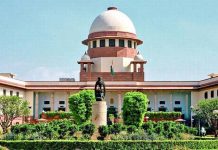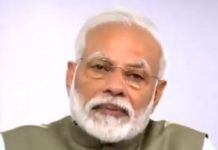Hunger striker Wangchuk’s journey from endorsing Ladakh’s UT status and hailing the withdrawal of Article 370 to fervently opposing it marks a significant course correction for Ladakhis, who now find that the government’s Aug 2019 order has left them marginalized. A report by Riyaz Wani

Ladakh’s struggle for constitutional rights and identity highlights the challenges it faces following its transition to a Union Territory status in August 2019. Once celebrated as a milestone in its quest for autonomy, this transition has now disillusioned the people which is symbolized by the 21-day hunger protest of prominent climate activist Sonam Wangchuk, which ended on March 26 and caught the attention of the nation.
Wangchuk’s journey from endorsing Ladakh’s Union Territory status and supporting withdrawal of Article 370 to fervently advocating against it has a ring of irony to it: In 2019, Wangchuk was at the forefront of the activists in Leh, who celebrated the withdrawal of Article 370 and the granting of union territory status to Ladakh. In a tweet, Wangchuk had then thanked the prime minister Narendra Modi “for fulfilling Ladakh’s longstanding dream,” and termed the far-reaching constitutional changes as a step towards “democratic decentralization.”
Since then, he has increasingly grown disillusioned with Ladakh’s UT status and come to a conclusion that the region was “better off with being a part of Jammu and Kashmir,” something he told the media last year. And now his fast, second since last year, shows that Wangchuk has moved 180 degrees from his 2019 position. Not just him but also the people of the Leh district while those in the neighbouring Kargil had largely opposed the UT status from the day one.
It reflects a broader shift in sentiment within the region, particularly in Leh district. Now the two districts have closed ranks to demand the reinstatement of lost constitutional protections
The Leh Apex Body (LAB) and Kargil Democratic Alliance (KDA) have emerged as the vanguards of this unified struggle, echoing the collective voice of Ladakhi communities in their demand for special rights and recognition. This newfound solidarity between Leh and Kargil, once divided along religious and cultural lines, reveals the gravity of their shared concerns and aspirations. However, the transition to a Union Territory has effectively dissolved the previously empowered Ladakh Hill Development Councils, leaving the region under direct central governance—a development that has fueled sentiments of marginalization and loss among the local population.
Despite the continuing protests, Ladakhi leaders have encountered lukewarm response from the central government, which has yet to meaningfully address their demands. The calls for tribal status, inclusion in the Sixth Schedule, job reservations, and parliamentary representation reflect a growing urgency to safeguard Ladakh’s identity and resources amidst fears of demographic change and cultural erosion. Drawing parallels with other states under special constitutional provisions, such as Mizoram, Tripura, and Sikkim, Ladakhi leaders seek to legitimize their demands within the framework of Indian constitutional law.
Central to this struggle is the significance of the Sixth Schedule, which Wangchuk and others argue is essential for preserving Ladakh’s unique socio-cultural fabric and ensuring local autonomy in decision-making processes.
The Ladakh Tourist Trade Alliance (LTTA) has also voiced concerns over outside investments in the region’s tourism sector, highlighting broader apprehensions regarding the impact of external influences on local economies and livelihoods. Last year, the LTTA, a coalition of trade, tourism, religious, and political organizations in Leh, passed a resolution opposing investment by outsiders in the tourism sector of Ladakh. The alliance warned that if such investments continue, they would impose restrictions on these investors through non-cooperation from the local travel-trade fraternity, as well as community and political organizations.
The alliance, comprising several prominent associations such as the All Ladakh Tour Operators Association Leh, All Ladakh Hotel and Guest House Association Leh, Ladakh Taxi Operators Cooperative Union Leh, and others, has joined forces with various religious and political bodies. Their collective aim is to safeguard the tourism industry of Ladakh and protect the interests of the local people.
Opposition to a widely perceived threat to Ladakh’s identity has incrementally grown over the past five years. Looking ahead, the road to resolution appears fraught with challenges, particularly amid the looming specter of general elections and a potential change in government leadership. Ladakhi communities continue to grapple with existential fears regarding demographic changes and the loss of their land, jobs, and resources in the absence of credible constitutional safeguards.
The total population of Ladakh, according to the 2011 census, is 2.74 lakh. While Leh with a population of 1,33,487 is Buddhist majority, and Kargil with a population of 1,40,802 is Muslim majority. Despite the region’s demographic diversity, with a slender Muslim majority, the region has witnessed a remarkable convergence of interests between its Buddhist and Muslim communities, who have set aside historical divisions in pursuit of a shared vision for their future. This unity presents a delicate dilemma for the central government, which must navigate the complexities of addressing Ladakhi concerns while avoiding perceptions of unequal treatment vis-à-vis Jammu and Kashmir.
It remains to be seen how the central government will respond to the deepening alienation in Ladakh. In charting a path forward, it is imperative for the central government to acknowledge the legitimacy of Ladakh’s demands and engage in genuine dialogue with regional stakeholders, which it has so far half-heartedly done.
The quest for tribal status and inclusion in the Sixth Schedule is not merely a matter of preference but a fundamental right rooted in Ladakh’s rich cultural heritage and unique socio-political context. As Ladakh confronts economic and political uncertainties in the aftermath of constitutional changes, a nuanced and inclusive approach is essential to fostering sustainable development and preserving the region’s distinct identity and aspirations.
But would the BJP government which is also widely expected to win a third term choose to offer credible constitutional guarantees to Ladakh to prevent the prevailing sense of disillusionment in the union territory becoming more intensified is anybody’s guess. The Ladakh crisis has created a difficult situation for the union government. More so, at a time when it has no immediate plans to even restore statehood to Jammu and Kashmir, nor even announce Assembly elections. It can’t be seen extending constitutional safeguards to Ladakh and denying the same to Jammu and Kashmir where similar anxieties about identity and culture prevail – albeit, currently in a dormant state.
The agitation in Ladakh has thus come as a moment of reckoning for New Delhi for New Delhi’s post-Article 370 policy towards Jammu and kashmir as well as Ladakh. It has so far seen the issues in regard to the former state as done and dusted and doesn’t want to reopen Pandora’s box by engaging with the now bifurcated and downgraded region on the granting of constitutional rights. But the persisting agitation in Ladakh has brought it to this very point.
Meanwhile, Ladakh’s demands have grown. The demands put forth by LAB and KDA include tribal status for Ladakh, incorporation in the constitution’s Sixth Schedule, job reservation for locals, and a parliamentary seat each for Leh and Kargil districts. Ladakhis are citing the cases of the other states and regions in the country which are protected by special constitutional provisions, an argument that is not just persuasive but also legitimate.













